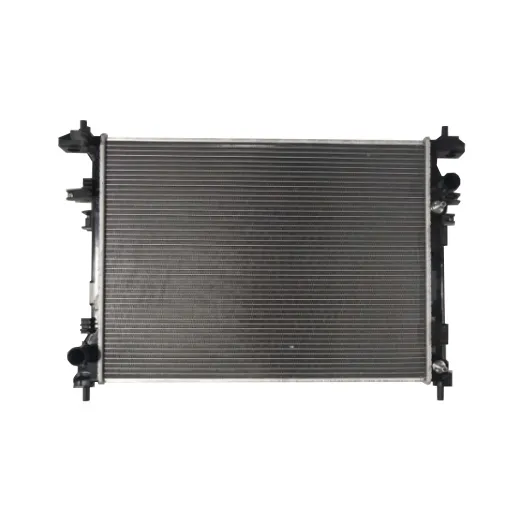Why Is the Automotive Aluminum Plastic Radiator Becoming the Standard?
2024-12-13
When it comes to the efficient functioning of a vehicle’s engine, the radiator plays an essential role in maintaining optimal temperature levels. Traditionally, radiators were made of brass or copper, but in recent years, automotive aluminum-plastic radiators have gained significant popularity. But why are they becoming the standard in modern vehicles? In this blog, we’ll explore the benefits, applications, and reasons why aluminum-plastic radiators are quickly replacing their metal counterparts in the automotive industry.
What Is an Automotive Aluminum Plastic Radiator?
An automotive aluminum-plastic radiator is a type of heat exchanger used in the cooling system of a vehicle. Unlike traditional metal radiators, which are made of copper or brass, aluminum-plastic radiators use aluminum for the core and plastic for the end tanks. The combination of these materials creates a lightweight, durable, and cost-effective solution for cooling engine components.
The aluminum core is responsible for dissipating the heat from the coolant, while the plastic end tanks house the inlet and outlet for coolant flow. This combination allows for efficient heat transfer while being resistant to corrosion, ensuring long-term reliability and performance.
Why Are Aluminum Plastic Radiators Gaining Popularity?
1. Lightweight Construction
One of the most significant advantages of aluminum-plastic radiators is their lightweight construction. Aluminum, being a light metal, helps reduce the overall weight of the radiator, which directly contributes to the overall weight reduction of the vehicle. This weight reduction can improve fuel efficiency and handling, which is crucial in modern automotive design. Lighter vehicles require less energy to operate, making aluminum-plastic radiators a key factor in enhancing fuel economy.
2. Corrosion Resistance
Corrosion has always been a significant concern in automotive radiators, particularly in areas where vehicles are exposed to road salts and moisture. Traditional copper or brass radiators are prone to corrosion over time, leading to leaks and reduced efficiency. Aluminum, on the other hand, is naturally resistant to corrosion. When combined with plastic end tanks, the aluminum-plastic radiator offers superior resistance to rust and deterioration, making it ideal for use in various environmental conditions.
3. Cost-Effective
In comparison to traditional metal radiators, aluminum-plastic radiators are more cost-effective to produce. The manufacturing process is more streamlined, and the materials used are less expensive, which can result in lower production costs for car manufacturers. These savings are often passed on to consumers, making aluminum-plastic radiators an affordable choice for a wide range of vehicles. Additionally, the increased durability and corrosion resistance can lead to fewer replacements and repairs over time, saving car owners money in the long run.
4. Improved Heat Dissipation
Aluminum has excellent thermal conductivity, meaning it can effectively dissipate heat from the engine coolant. This is essential for maintaining the engine at an optimal operating temperature. Aluminum-plastic radiators are designed to maximize the surface area for heat transfer, ensuring that the coolant circulates efficiently and maintains a stable engine temperature. The result is better overall engine performance and reduced risk of overheating.
5. Enhanced Durability and Strength
Although plastic is often considered a less durable material than metal, the plastic used in these radiators is specifically designed to be tough and resistant to impact and cracking. Modern engineering techniques ensure that the plastic end tanks can withstand the pressures of the cooling system without compromising the structural integrity of the radiator. The combination of aluminum and plastic offers the perfect balance between strength, durability, and lightweight properties.
6. Design Flexibility
Aluminum-plastic radiators offer greater flexibility in design compared to traditional metal radiators. The plastic end tanks can be molded into various shapes and sizes, making it easier for manufacturers to customize radiators to fit specific vehicle models. This flexibility in design allows for more efficient cooling systems that can meet the unique needs of different engine types, further enhancing the radiator's performance.
Applications of Aluminum Plastic Radiators
Aluminum-plastic radiators are used extensively in the automotive industry and beyond. Here are some common applications:
1. Passenger Vehicles
The most common application for aluminum-plastic radiators is in passenger vehicles, including sedans, SUVs, and compact cars. Manufacturers prefer them due to their cost-effectiveness, efficiency, and ability to meet the increasing demands for lightweight components.
2. Electric Vehicles (EVs)
With the rise of electric vehicles, aluminum-plastic radiators have found a prominent place in EV cooling systems. Since electric vehicles often require more efficient thermal management due to the heat generated by battery packs, aluminum-plastic radiators offer an effective and lightweight solution.
3. Heavy-Duty Trucks and Commercial Vehicles
Aluminum-plastic radiators are also used in heavy-duty trucks, buses, and other commercial vehicles. While these vehicles require more robust cooling systems, the durability and heat dissipation properties of aluminum make it a viable option for large-scale engines that require consistent cooling.
4. Motorsport and Performance Vehicles
High-performance vehicles, including those used in motorsports, require top-tier cooling systems. The lightweight nature and superior heat dissipation of aluminum-plastic radiators make them an ideal choice for performance vehicles where weight and engine temperature regulation are crucial.
Are There Any Disadvantages of Aluminum Plastic Radiators?
While aluminum-plastic radiators offer many advantages, there are a few potential drawbacks to consider:
1. Potential for Plastic Tank Damage
Though the plastic end tanks are designed to be durable, they may still be more prone to cracking or damage from impacts compared to traditional metal tanks. However, advancements in plastic technology have minimized these risks, and proper handling can significantly reduce the chance of damage.
2. Compatibility with Older Vehicles
Aluminum-plastic radiators may not be directly compatible with older vehicles that were designed to accommodate brass or copper radiators. In such cases, retrofitting may be required, which can add to the cost and complexity of the replacement.
Conclusion
The automotive aluminum-plastic radiator is quickly becoming the standard due to its lightweight construction, durability, corrosion resistance, and cost-effectiveness. As the automotive industry continues to focus on improving fuel efficiency, reducing weight, and enhancing engine performance, aluminum-plastic radiators will likely play an even more significant role in the development of modern vehicles.
Whether you're looking to replace an old radiator or are considering an upgrade for your vehicle, the aluminum-plastic radiator provides a reliable and efficient solution. As the industry moves toward more advanced and environmentally friendly materials, the trend of aluminum-plastic radiators is expected to continue growing, further cementing their place as the future of automotive cooling technology.



